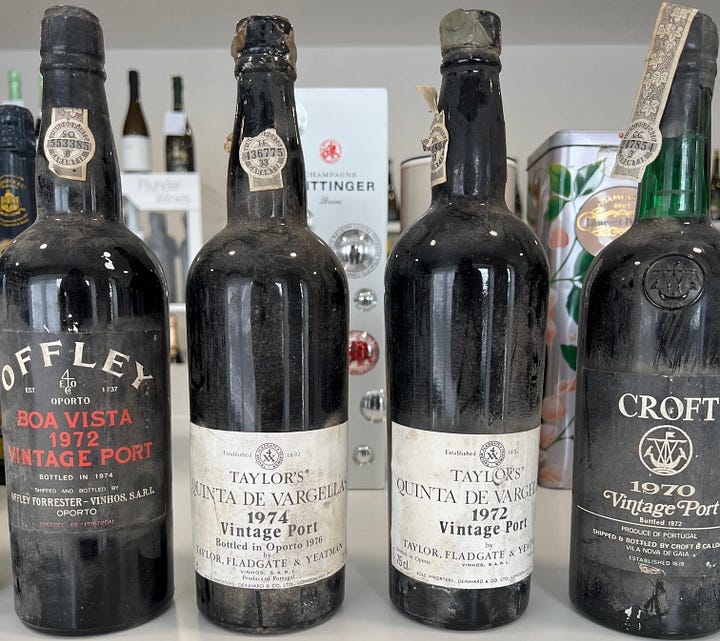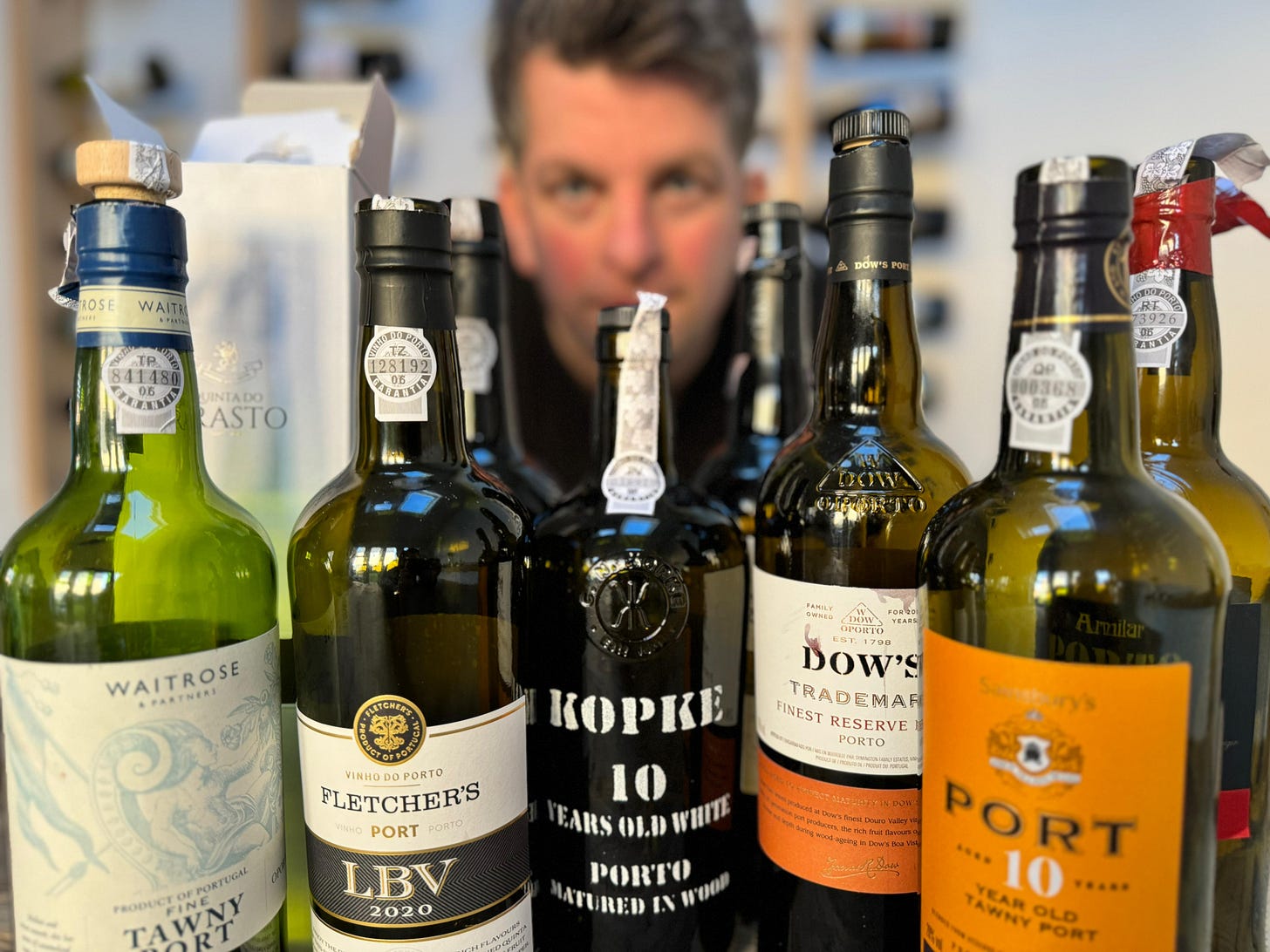Port—so many of us love it, even if we have no idea what those words on the label mean. That’s why I thought it’d be useful to break down the different styles and share my recommendations from my travels, supermarket tastings and research.
Let’s make Port a little less complicated and more enjoyable!
First of all, what is port and why does it exist?
Let’s rewind to the 17th century. British merchants, searching for a way to preserve their wine during the long voyage back to England, began adding brandy to their wine to last the journey (hic).
What started as a practical solution quickly evolved into a much-loved style of wine, capturing the hearts of royals and wine lovers across Europe.
Port is now made by adding a neutral grape spirit to wine, known as aguardente, which halts fermentation. This process keeps the natural sweetness of the wine while increasing its alcohol content. Although often referred to as brandy, the fortification spirit differs significantly from the commercial brandies familiar to most.
After fortification, the wine is aged—often in barrels stored in "lodges" (cellars) in Vila Nova de Gaia, just across the river from Porto. Once aged to perfection, it is bottled.
The name "port" was coined in the latter half of the 17th century, taking inspiration from the city of Porto, a historic seaport at the mouth of the Douro River where the wine was shipped to markets across Europe.
The Douro Valley, where Port is exclusively produced, was officially defined as a protected wine region in 1756. This makes it the third oldest demarcated wine region in the world, following Chianti (1716) and Tokaj (1730).
Fast forward a few centuries, and today we’ve got a wide range of Port styles on our shelves, each with its own story and character...
White Port
White Port is a style made from white grape varieties, rather than the red grapes typically used in traditional port.
There are three ways to enjoy white port:
As an aperitif: Dry White Port is often served chilled with tonic water, ice, and a slice of lemon or orange for a refreshing drink known as "Porto Tonic."
In cocktails: Makes it a great base.
Straight up: On their own, slightly chilled.
Try this: Majestic - Taylor’s, Fine White, 50cl £11.99 £15.99
This is the perfect choice for your “Porto Tonic.” Plenty is happening in this wine, with honey and floral flavours shining through. Currently available at a fantastic price, it’s an excellent way to serve something a little different and refreshing for your guests.
Try this: Waitrose - Kopke, Colheita, 2010 £35.99 £42.99
This Kopke is a complex, rich and nutty masterpiece. I’ve tried this at the Waitrose press tasting for the past few years and it always delivers more than Santa. Chill this slightly and let the magic unfold.
Pink Port
Pink (Rosé) port, is a relatively modern style introduced to appeal to those who enjoy lighter, fruitier wines (and probably because normal Rosé is on the upward curve). Made from red grape varieties, Pink Port undergoes a shorter maceration (skins in contact with juice) period than traditional red ports, allowing the juice to remain in contact with the grape skins for just enough time to extract its blush pink colour and delicate flavour
Try this: M&S - Pink Port £10
If you like Rosé Zinf then this could be the ticket. Think Chicken Wine on steroids. Fruity, sweet and fun.
On to the Reds…
Ruby Port
Young, fruity, and full of life. Aged for up to three years, it’s bottled young to keep that sweet, vibrant and juicy character. If you like this style you’re in for a treat because it’s the cheapest on the shelves.
Try this: ASDA - Cockburn's, Fine Ruby £8 £13.50
Cockburn’s does the job well at a very friendly price — lots of sweet, juicy, concentrated red fruit.
Reserve Port
This takes things up a notch from your standard ruby. It’s very much like a ruby port but a blend of higher-quality wines and aged a bit longer. The result? A richer, smoother experience that feels just a touch more indulgent.
Try this: Sainsbury’s - Dow's, Trademark, Finest Reserve £10 £12.75
The Dow’s held its own when trying it against higher-priced alternatives — Plummy, bold and as smooth as a dog’s bottom.
Tawny Port
If you prefer a slightly lighter, more savoury style of Port, Tawny is the way to go. The name refers to the colour the wine develops after ageing. By law, a tawny must be aged for at least two years, but you’ll also find much older examples.
What sets Tawny apart is its ageing process. The wine matures in small barrels, allowing it to take on nutty, caramel flavours while undergoing oxidation. This softens the sweetness and adds a rich, complex character. Bottles are often labelled with their age—10, 20, 30, or even 40 years—indicating the average age of the wine inside. I’d even recommend slightly chilled Tawny.
Try this: Waitrose - Blueprint, Tawny £9.99
This is a star buy at this price. Soft, nutty and fruity.
Try this: Sainsbury’s - 10yr Tawny, Taste The Difference £21
Decent option for a ten-year-old Tawny. A lot of oak coming through here against dried fruit flavours.
Try this: Wine Society’s - Graham's Tawny 20 Years Old £44
If you’re after something a little more special—a standout version—then Graham’s is superb. Highly rated and award-winning, it offers lots of complexity that evolves in the glass with every sip. Think dried fruits like fig and sultana, a rich nuttiness, and a surprising elegance. A truly wonderful thing!
Colheita Tawny Port
Colheita is a Tawny Port but from a single vintage, aged for at least seven years in oak but often much longer. It combines the richness of Tawny with the uniqueness of vintage character.
Try this: Waitrose - Kopke, Colheita, Tawny 2005 £35.99
It’s unusual to find an option from a supermarket of this style and this is what makes Kopke Colheita Port such a fantastic option — Plenty of age (19 years), depth and flavour.
Late Bottled Vintage (LBV)
LBV Port comes from a single year and is aged between four and six years before bottling. There are two styles: filtered (ready to drink) and unfiltered (best with a bit more ageing). Think of LBV as vintage Port’s more approachable bro. There are many options available for this style but these are two I’ve enjoyed at different price points.
Try this: Aldi - Fletcher's LBV £11.99
Aldi’s Port is very impressive at this price competing well against higher-priced alternatives (only available in-store).
Try this: Ocado - Sandeman Late Bottled Vintage 2015 £21 £25.55
Sandeman is a personal favourite of mine throughout the years and the first house I visited on my travels to Porto a few years ago. Lots of dark fruit here beautifully complimented by that signature sweetness. A well-balanced port.
Crusted Port
This one’s for the adventurous. Crusted Port gets its name from the sediment it forms in the bottle. It’s a mix of wines from a few harvests, bottled unfiltered, so you’ll want to decant it first. Bold, full-bodied, and a steal compared to vintage Port.
Try this: The Society's Exhibition, Crusted Port, Bottled 2013 £19.50
You can trust the Society to do port well. Award-winning and you have a lot of complexity from all of that sediment. More of your tertiary flavours here from the time spent ageing with tobacco and leather notes popping up. Brilliant price!
Single-Quinta Vintage Port (SQVP)
Like Vintage Port but from a single estate, SQVPs are made in non-declared years. They’re less pricey but still top-notch, offering a taste of a specific vineyard’s character.
Try this: Tanners - Dow's Quinta do Bomfim, Single-Quinta, Vintage Port 2013 £38
This wine has a lot of red fruit and a noticeable amount of spice. Slightly drier in style and supremely delicious.
Vintage Port
Why is Vintage Port the top dog of the fortified world? It is only made in exceptional years, with grapes from the best vineyards. It ages beautifully, transforming over decades for the better. It still carries that romance of what wine is all about. To suggest one Vintage port is tricky as it’s such a personal choice so here are a couple of merchants to look at.
Try this: Hedonism Wines port range
You have to pay a little bit of premium shopping at Hedonism but you can’t argue with their list of vintage port options and their service.
Try this: Seckford Wines port range
You will do well to find a rare port selection as you will find at Seckford Wines. Their list is also ever-changing so if you do see something you like grab it while it’s there!
Try this: Waitrose - Fonseca Vintage Port 2019 £89.99
If you need a vintage port from the supermarket then this is a cracking option. I tried this during my time in Portugal and it didn’t disappoint. It is supremely young though so if possible let it rest for a long time.


Ok, well that’s a wrap - if you have any questions about port then please leave them in the comments section below and I’ll try my best to provide the answers.
Cheers, Luke
P.S. Apologies for any typos or grammatical errors—this content is entirely my own work, as always.









Great advice on port types. It may be very naive but I think a lot of people are unsure what the rules are on longevity of open bottles of port and decanted port. Can you enlighten?
Port is the nectar of the gods!